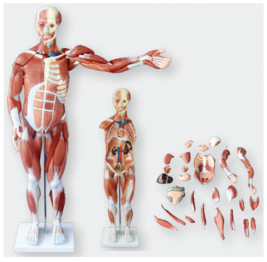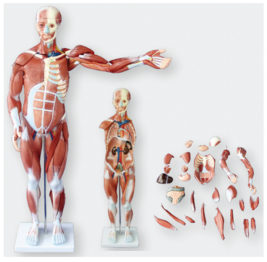ADA MED SUPPLY LIMITED
Phone:+86 19937901373
Tel:+86-0379-65160607
Email:adaanatomy@adaanatomy.com

Article tag: Muscle anatomy model medical anatomy model

In medical education and clinical practice, simulation models have been an indispensable teaching and training tool. In recent years, with the continuous progress of medical education and technological innovation, muscle anatomy with internal organs model has gradually emerged and become a new favorite of medical practical training. This paper will introduce and analyze this model in detail.

The Muscle Anatomy with Viscera model is a highly simulated medical model that combines the presentation of muscle anatomy and visceral structures to provide an intuitive, comprehensive learning platform for medical students, physicians, and other medical professionals. The models are usually made of high-quality materials, are highly durable and realistic to the touch, and are able to simulate the muscle and internal structure of the real human body.
This model has obvious advantages in medical practice. First, it can help students and doctors better understand the structure and function of the human body. By observing and manipulating the model, they can gain insight into the shape, location, proximity and interactions between the muscles and internal organs. This intuitive way of learning helps students to form deep memories and improve learning results.
Secondly, the muscle-anatomy attached viscera model also provides a wealth of practical opportunities. Students can perform various surgical simulations on the model, such as muscle cutting, suturing, internal organ removal, etc. This practical training not only helps students familiarize themselves with surgical procedures, but also improves their operational skills and resilience. In the simulated operation, students can practice repeatedly, gradually master the surgical skills, and lay a solid foundation for future clinical practice.
In addition, the muscle anatomy attached viscera model is highly flexible and customizable. According to different teaching needs, the model can be customized with different functions and display content. For example, teachers can gradually increase the complexity and difficulty of the model according to the course progress and students' mastery, so as to help students gradually master higher-level knowledge and skills.
In conclusion, as a new medical training tool, muscle anatomy with internal organs model has significant advantages and wide application prospects. It can not only help students and doctors better understand the structure and function of the human body, but also provide rich practical opportunities and flexible teaching methods. With the continuous progress of medical education and technological innovation, it is believed that this model will play a more important role in the future medical training.